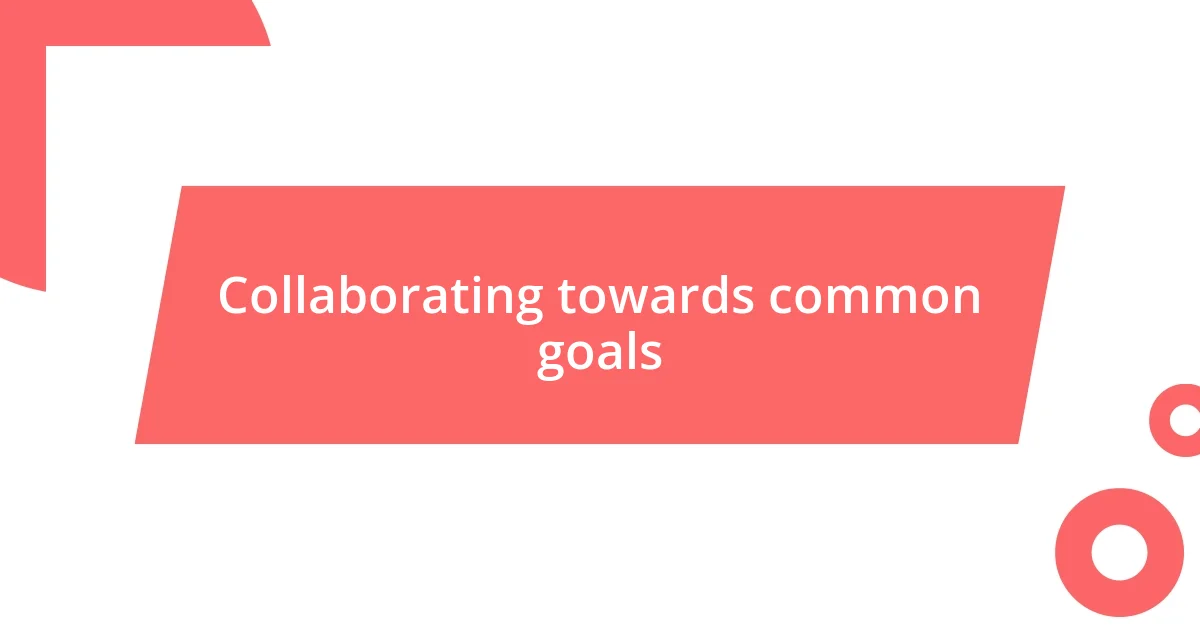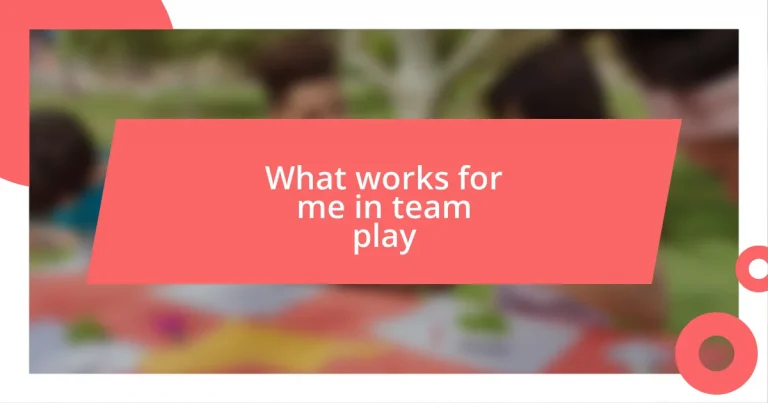Key takeaways:
- Effective communication is essential for team dynamics, and can be fostered through regular check-ins, adapting communication styles, and active listening.
- Building trust and respect among team members enhances collaboration and creates a supportive environment, which can lead to improved performance and stronger relationships.
- Embracing diversity in teams leads to innovative solutions and enriches team experiences, highlighting the value of different perspectives and backgrounds.

Understanding team dynamics
Understanding team dynamics is fascinating because it reveals the underlying currents that drive collaboration. I recall a time when a project I was part of suddenly shifted gears. It was then that I realized how essential communication was; one misstep in our understanding led to confusion and frustration among team members. Have you ever noticed how a single voice can make a huge difference in a team discussion?
As I worked through that experience, I understood more about interpersonal relationships and individual strengths. Every team member brings unique qualities to the table, which can either harmonize or clash, depending on how they interact. This realization led me to explore how recognizing and harnessing each person’s strengths can boost the entire group’s performance. Have you thought about what strengths you bring to your team?
Moreover, emotional intelligence plays a crucial role in team dynamics. I remember a time when tensions were high during a deadline crunch. One teammate, feeling overwhelmed, expressed their frustration, and instead of escalating the situation, we paused to listen and empathize. This act of understanding shifted the atmosphere from stress to support. Isn’t it interesting how a little compassion can transform a team’s energy?

Identifying personal strengths
Identifying personal strengths is a vital step in understanding how to contribute effectively to a team. I remember when I took the time to assess my abilities and realized that my skill in problem-solving often brought clarity during tumultuous discussions. Recognizing this allowed me to step into a leadership role when necessary, which not only benefited the team but also boosted my confidence. Have you ever taken the time to truly reflect on what you excel at?
To help you identify your strengths, consider these questions:
- What tasks do I enjoy doing the most?
- In which areas do I receive positive feedback from others?
- What skills do I often find others seeking my help with?
- When do I feel most energized and engaged during teamwork?
- Are there specific challenges I find easier to navigate than others?
By exploring these points, you can gain insight into what you bring to the team and how to leverage those strengths effectively.

Effective communication strategies
Effective communication is the backbone of team play, embodying both clarity and openness. I’ve found that opting for regular check-ins can create a steady flow of information, ensuring everyone is on the same page. During one particular project, our weekly meetings helped us air concerns and share updates, ultimately fortifying our collaboration. Have you ever thought how touchpoints can keep a team aligned?
Additionally, adapting my communication style to meet the preferences of my teammates has made a significant difference. Early in my career, I noticed some colleagues preferred concise emails, while others thrived on in-depth conversations. When I tailored my approach, it not only made them feel valued but also fostered a collaborative atmosphere where ideas could be shared freely. Isn’t it fascinating how a small shift in communication can enhance teamwork?
Listening actively takes effective communication to another level. I remember a brainstorming session when one quieter team member mentioned an idea that transformed our project. I realized I had to consciously create space for everyone to contribute. This experience highlighted the importance of not just talking but genuinely engaging with my colleagues. Have you ever experienced the power of listening in a group setting?
| Effective Communication Strategies | Description |
|---|---|
| Regular Check-Ins | Create a structure where team members can openly share updates and concerns. |
| Adapt Communication Style | Customize your communication approach based on team preferences to foster a more inclusive environment. |
| Active Listening | Encourage dialogue by listening carefully, ensuring all voices are heard and valued. |

Building trust and respect
Building trust is like planting seeds in a garden; it requires time and care to grow. I vividly remember working with a team where my colleague and I committed to sharing our honest thoughts, even when it was tough. This openness created an environment that allowed vulnerability, and soon enough, our mutual respect blossomed into a solid foundation of trust. Have you ever been in a situation where honesty helped strengthen your bonds with others?
Respect extends beyond just acknowledging each other’s opinions; it’s about valuing the individual behind those thoughts. In one team project, I took extra time to learn about my colleagues’ backgrounds, interests, and strengths, which helped me appreciate their unique perspectives. I could see how this respect transformed our interactions, making everyone feel seen and heard. Isn’t it remarkable how a simple act of curiosity can foster stronger relationships?
Ultimately, trust and respect form the cornerstone of effective teamwork. I recall a challenging project where trust was tested due to looming deadlines. We held a candid conversation, affirming our commitment to support each other, which not only helped us push through but also deepened our respect for one another’s capabilities. I often wonder—how much stronger could teams become if they prioritized authenticity and appreciation for one another?

Collaborating towards common goals
When it comes to collaborating towards common goals, I often find that aligning on a shared vision is paramount. In a team project I participated in, we started by visualizing our end goal together. We gathered around a whiteboard, jotting down our dreams and expectations. This simple act of collectively envisioning our objectives created a compelling motivation and a sense of ownership among all of us. Have you ever witnessed how a united vision can energize a team?
Working collaboratively also means being adaptable to each other’s strengths and weaknesses. I recall a time when we had to pivot our approach because some teammates excelled in creative brainstorming, while others were more suited for detailed analysis. Acknowledging this dynamic allowed us to distribute tasks in a way that played to our individual strengths, ultimately leading us to a successful outcome. Isn’t it interesting how recognizing what others bring to the table can turn a frustrating scenario into a fruitful one?
More than just achieving tasks, collaborating towards common goals involves nurturing a supportive environment. There was a project where our timelines got tight, and stress levels soared. Instead of retreating into our silos, we actively encouraged each other, celebrated small milestones, and shared in the pressure. This sense of communal support made the journey not only bearable but enjoyable, and it reminds me that collaboration is as much about the experience as it is about the end result. Have you ever felt that the journey together was what truly mattered?

Embracing diversity in teams
Embracing diversity in teams opens up a world of possibilities that I have found incredibly enriching. I remember this one project where our team comprised individuals from various cultural backgrounds. Each person brought a different approach to problem-solving, which led to creative solutions I would never have imagined on my own. This melting pot of perspectives made me wonder—how often do we limit our potential by sticking to what we know?
The beauty of diverse teams lies in their ability to challenge each other’s ideas constructively. I once participated in a brainstorming session where someone proposed a radical idea that caught me off guard. At first, I was skeptical, but as we discussed it further, I started to see its merits. This experience taught me that embracing different viewpoints not only broadens my understanding but also fuels innovation. How many times have you dismissed an idea simply because it felt outside your comfort zone?
When we celebrate our differences, we create an atmosphere of inclusivity that can drive motivation and engagement. I distinctly recall a team lunch where we shared traditional dishes from our respective cultures. Amid laughter and storytelling, barriers dropped, fostering a sense of belonging that translated into our work. The energy in that room was palpable, making me realize just how crucial it is to create spaces where everyone feels valued. Isn’t it incredible how sharing our backgrounds can enrich our teamwork experience?

Reflecting on team experiences
Reflecting on team experiences often brings to light the subtle yet powerful ways we connect with one another. I once led a team debrief after a project that had its ups and downs. As we sat in a circle, each person shared their feelings about the journey, from triumphs to frustrations. I remember feeling a wave of relief wash over me when we opened up about our vulnerabilities. It made me realize just how essential it is to carve out space for honesty in team settings. Have you ever found that the act of sharing your experiences creates deeper bonds?
Thinking back, I often see how challenges we faced together shaped our growth as a team. During a particularly intense project, we missed a few deadlines, which left some of us feeling like we had let each other down. Instead of pointing fingers, we took the time to evaluate what went wrong. I was genuinely surprised at how openly admitting our missteps led us to uncover solutions that strengthened our collaboration moving forward. Isn’t it fascinating how discomfort can, if handled well, pave the way for resilience and improvement?
I believe that every team experience is an opportunity for reflection and learning. I recall an instance where a small misunderstanding led to a massive debate. What surprised me most was how we turned that moment into an exploration of communication styles. By analyzing what had gone awry, we not only resolved our issue but also developed a framework for better dialogue in the future. It’s moments like these that make me wonder—how often do we let miscommunication teach us something valuable?














